As Australia suffered a major economic crisis in the 1930s, sections of business and the ruling class began to encourage a growing fascist movement, writes Tom Orsag
In recent years the menace of fascism has re-emerged in Europe, from racist street marches held by English Defence League thugs to Golden Dawn’s string of murders in Greece.
Australia has its own history of mass fascist movements. The most serious was the emergence of the fascist New Guard in NSW in the late 1920s. It came as a product of a period of intense class struggle and working class radicalisation that led to the election of a reformist state Labor government amidst the worst economic crisis in the history of capitalism.
The New Guard is best-known for the actions of Captain Francis De Groot, who upstaged proceedings at the official opening of the Sydney Harbour Bridge in March 1932 to cut the ceremonial ribbon with his sword.
However at one point the New Guard made plans to kidnap Jack Lang, the elected NSW Labor Premier, and stage a coup d’état to place NSW under martial law.
In the 1920s, sections of the Australian ruling class had become sympathetic to fascism and its aim of completely destroying trade unions, the left and working class organisations. There was particular admiration for what Benito Mussolini, the fascist dictator of Italy, had achieved when he came to power in 1922. This included the assassination or internment of all opposition leaders and the banning of all opposition political parties and newspapers.
During the 1925 seafarers’ strike, the Sydney Morning Herald reminded its readers that, “Italy…was only saved from Red Dominance by the heroic remedy of Fascism—a dreadful medicine for sure, and yet less bitter than the plague it stopped.”
When he returned from Italy in 1923, the Nationalist Premier of Victoria, Harry S W Lawson, proclaimed Mussolini as the one, “whom Providence wanted to lead Italy”.
The manager of the Melbourne branch of the Australian Bank of Commerce, today’s Westpac, was pleased to hail Mussolini as, “certainly one of the most wonderful men I have ever seen.”
At Anzac Day parades between 1930 and 1937, Italian fascists were allowed to march as a distinct group. Their fascist salutes provoked no adverse comment in the major newspapers.
Secret and not-so-secret right-wing militias emerged as Australia headed into Depression in late 1929 and Labor Party governments took office.
Anti-democratic ideas became respectable. The press argued openly that such militias might be proved necessary if Labor was re-elected or things got “out of hand”.
There were numerous calls for a dictatorship or a government run by “a committee of experts”. Many conservatives hoped that General John Monash, a WWI commander, could be installed as dictator. The Bulletin argued in 1930 that,
“There is only one man who can save Australia…John Monash. Let the remnants of the Old Brigade rally around him and give him a council of financial experts.” Monash rejected the idea.
Right-wing mobilisation
On 18 February 1931, the New Guard was formed by retired Colonel Eric Campbell, a solicitor, and seven other ex-officers turned businessmen, at the Imperial Service Club in Sydney.
At its peak in November 1931, it claimed 36,000 active members, and 80,000 members in total. This is enormous considering Sydney then had only 1.5 million people and a police force of 1850.
Its dramatic rise came in response to the election of Labor’s Jack Lang as NSW Premier in October 1930.
Within 100 days of Lang’s election, no less than 18 separate right-wing action groups were formed. This included four movements in regions like New England and the Riverina demanding separation from NSW. In 1931, 10,000 people rallied in Wagga Wagga to demand a separate state.
All these groups received backing from big business. Prominent New Guard supporters included Sir Frederick Stewart, a bus company owner and director of the Sydney Sun newspaper, and the aviators Charles Kingsford Smith and Charles Ulm.
The New Guard’s Finance head was Captain James R. Patrick, of Patrick stevedore and shipping company. He was assisted by F. W. Radford, the managing director of Patrick’s shipping line, Charles MacDonald, head of the Northern (NSW) Collieries Association and Sidney Bennett of the Retailers’ Association.
Its membership was drawn mainly from the wealthy professional middle classes in banking, law and insurance, the Stock Exchange, and the wealthy North Shore and Eastern suburbs of Sydney.
Campbell called them “the right-thinking young men of the business and professional classes.”
The New Guard aimed at the “Suppression of any disloyal and immoral elements in government, industrial and social circles.” This meant attacking working class demonstrations and strikes in particular. Campbell had attempted this in August 1925 during the seafarers’ strike.
Stanley Bruce, the conservative Prime Minister, said he wanted a force of scabs to break the strike if the police couldn’t do it. Campbell and another former military officer handpicked 500 ex-soldiers. But in the end they weren’t needed.
What differentiated the New Guard from other right-wing groups was that it aimed to build a para-military organisation capable of physically crushing left-wing demonstrations, political parties and unions. This focus on building a mass movement of street thugs marked it out as a fascist group distinct from conventional right-wing parties.
Fascism is a mass movement of the middle class based on extreme nationalism. In the period of crisis in the 1930s capitalist classes around the world began to consider using such movements to physically smash working class organisations and ensure the survival of capitalism. Both in Germany and Italy where the fascists came to power under Hitler and Mussolini, the capitalist class and their political representatives in the old conservative parties handed them power.
Lang Labor
The Lang Labor government in NSW was the focus of the right’s loathing because it dared to take modest steps to shield the working class from the Depression—at the expense of business and the rich.
Unemployment grew to 26 per cent by December 1930 just after Lang took office.
While the federal Labor government capitulated to business’ demands and forced through cuts, Lang campaigned against austerity and promised to create jobs.
He proposed his own “Lang plan” in an effort to reduce repayments on government debt. This did not involve cancelling the debt outright but only paying British creditors less interest.
Lang also cut the working week from 48 to 44 hours, and passed a law protecting tenants who couldn’t pay their rent from eviction. This sent the ruling class into an apoplectic rage.
But it was not just the Labor government’s actions, but the wider growth of the socialist left that scared the ruling class.
The working class was radicalised by the economic depression and the employers’ attack on workers’ living standards. The Communist Party went from 250 members in 1928 to 2000 by 1931.
The Left of the Labor Party in NSW created ”Socialisation Units” to campaign for Labor to introduce socialism.
At the NSW Labor Party Conference in 1931 the Socialisation Units won a motion which called for the “establishment in three years of a socialist state by nationalisation of specified industries by commissions with direct workers and producers’ control.” Lang and his supporters overturned the motion the next day, but there was nonetheless terror amongst the ruling class.
In response the Sydney Morning Herald wrote, “the evil menace of Sovietism in this land, a secret junta planning civil strife and disruption, must be overthrown and stamped out.”
The class polarisation meant the New Guard grew to between 10-20,000 members by the end of May.
The New Guard organised to physically attack Communist Party members at their open air street meetings on Friday nights. On 16 October, 200-300 Guardsmen smashed up a Communist Party meeting at Bondi Junction.
In response, the next Friday the Communist Party organised a “United Front Free Speech Movement” meeting. Around 800 people turned up—and the New Guard stayed away.
As the December 1931 Federal Election approached, Communist Party open-air meetings were attacked in Drummoyne, Kings Cross, Bondi, Leichhardt, Lane Cove, Kogarah and Hurstville. A Labor Left meeting at Enfield was also attacked. In Canterbury, a meeting was broken up by the New Guard, with a gunshot fired at Jim McNeil, a Communist Party member.
McNeil described one New Guard attack, “They tried to break up a meeting in Rozelle once, but there were thousands of unemployed in Balmain and Rozelle. The workers fought back. They bashed into them and finally had them running like hares off the street.”
After another attack in Wollongong the Daily Telegraph, sympathetic to the New Guard wrote, “The Reds were prepared and many drew heavy batons at the first sign of attack.”
Two days later, 4000 workers turned up at an anti-New Guard rally.
The next day the same number turned up at an “Anti-Fascist United Front Committee” meeting, chaired by the Secretary of the Illawarra Trades and Labour Council.
The Communist Party understood that the New Guard was building a deadly weapon for use against strikes and protests of all kinds, and that it was futile trying to convince them with reasoned argument or expecting the courts to deal with their violent attacks on protests.
In such a period of crisis, if fascists can stage “successful” actions employers and the ruling class can begin to see them as a useful tool against strikes and protests. This is why efforts to physically confront fascists and deny them the ability to march and control the streets are key to stopping them.
On the evening of 13 May 1932, Governor Sir Philip Game sacked NSW Premier Jack Lang, an unprecedented act in Australia politics.
A brigade of several hundred New Guardsmen was stationed in the basement of a department store building, several hundred metres from State Parliament House.
They had threatened to march upon Parliament House and stage a coup attempt if Lang did not resign before seven o’clock. Lang was sacked at six o’clock.
With Lang gone, the New Guard eventually collapsed as the level of working class mobilisation and struggle receded.
The New Guard was a product of the class conflicts and crisis produced by capitalism. Like fascist movements elsewhere, it represented an option for the ruling class in its efforts to maintain workers’ exploitation. As the economic crisis produces new racist movements today, we must learn the lessons in order to stop these movements once again.





